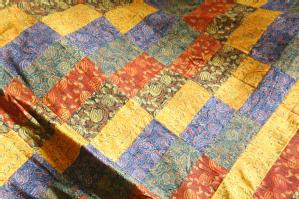Ramji Devraj Marwada and Family
|
Ramji Devraj Marwada Age: 32 No formal education
Date of interview: 29/5/2012 Place of Residence: Hodko
|
Hansbai Devraj Age : 62 No formal education
Age: 29 Education: Class 4 |
Download |
A quilt by Ramji |
Interview Summary
It was quite an awe-inspiring experience to visit one of the small settlements in the village of Hodko, Banni taluka, in Kachchh. Although Ramji’s quilt-making profession has connected him to global markets, his household and lifestyle show few traces of modernity. This is indicative of some of the incongruities in the current life of the artisans of Kachchh: they are simultaneously connected to far-flung places, yet remain rooted in their traditional, age-old way of life.
Discussing his family history, Ramji mentioned that his ancestors migrated from Sindh, Pakistan to Marwar, and from there they reached to Gujarat to finally settle down in Banni. The unsettled, impermanent pursuits of the family provoked this regular migration. In Banni, Ramji and his five brothers Karsan, Kanji, Parmar, Meru and Samat have settled with their families. Of the six brothers, Ramji, Karsan, Meru and Samat are involved in the quilt-making and exporting business. Ramji, Karsan and Samat currently work together, while Meru has a separate business and takes orders from FabIndia. The family are in possession of three workshops.
Discussing how the family came to adopt this business, Ramji and Karsan both replied that traditionally, the women of the household made quilts, mainly for the wedding trousseau, which required around fifteen to twenty. Looking at the market potential of the craft however, they developed their quilt enterprise and expanded substantially in just fifteen years. Over this time, the kind of fabric they used has changed from polyester, poplin and casement to the block-printed cotton fabric. Since they have started to use an American design catalogue and natural-dyed fabric, their venture has become profitable and has successfully linked them to global markets. In designing quilts for new consumers they have blended traditional stitching with on-trend patterns.
In 2010, they visited Santa Fe, New Mexico. They were overwhelmed with the positive response they received and were impressed with the arrangements made for them as they were well guided throughout their trip. In July 2012, they are awaiting their second visit to the USA and also hope to visit other countries. In terms of profits margins, Karsan explains that between the local markets of India and foreign markets there is around four times the difference.
Women of the household and the locality play an important role in the intricate stitching (tanka) of a quilt. The quilt makers readily acknowledge their contribution and stress that without the support of the women they cannot work. The preliminary work of cutting, designing, machine stitching and lining is managed by Ramji, his brothers and tailors on three machines. To meet bulk orders, the brothers often outsource the work of stitching to the female workers of the Muslim community from the nearby villages. Around two hundred and fifty women are employed in this single enterprise, demonstrating the importance of the industry for local employment and the high demand for quilts. They are paid according to the amount of work completed. They receive around 150 rupees for their daily labour and can earn approximately 3000 to 4000 rupees a month. One of the women after working with the family managed to buy herself 19,000 worth of gold earrings and spent 7000 Rupees on anklets. Meru’s wife has won a merit award for her muttwa embroidery and the family are now intending to send in other entries for the award.
It takes approximately 12 days to make one quilt; the hand stitches all over the quilt are completed in about 10 days. Since the making process is laborious and time consuming, Ramji and his team at times feel a great deal of pressure (kasokas). They are compelled to supervise workers, design products, buy raw materials, look into auditing, handle customers, attend exhibitions and coordinate with exporters. They are busy throughout the year because of all these different aspects. When the quilt-selling season approaches they attend exhibitions and trade with their partners in Ahmedabad, Banglore and Bombay. In former times, Ramji’s mother Hansbai says that she and her husband attended several such fairs every year, in places such as Delhi, Surajkund and Hyderabad.
For the products with the highest prices, quality is key. Their range starts from 1,500 rupees and goes up to 8,000 for particularly special orders. Most regular sales fall within the 2,000 to 2,500 range. Through using straight quilt-stitching they now also make bed sheets and cushion covers. Their bed covers with a reversible lining is now their best-selling item. Combining fine fabrics, high-quality production processes and new (western) designs has increased their profits.
For one indigo-dyed bed cover, 15 different patchwork designs were embedded. This was intended for the US market. The art of stitching depends on a basic knowledge of arithmetic, and if one stitch is missed then the whole design could be spoiled. This is especially the case with the traditional gambhira design which calls for perfect vertical and horizontal stitching. The quilt makers directly stitch onto the fabric without any drawing and tracing.
Karsan strongly feels that they are in need of funding and encouragement in order to continue to expand as their main problem is cash flow.

